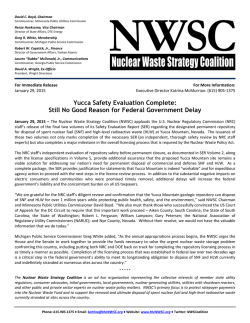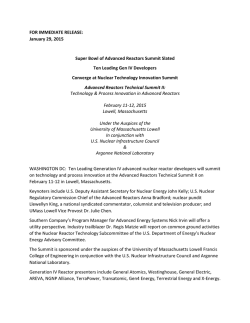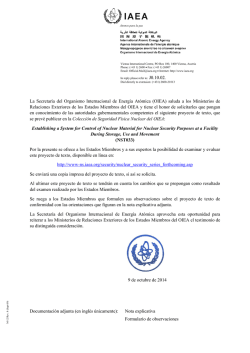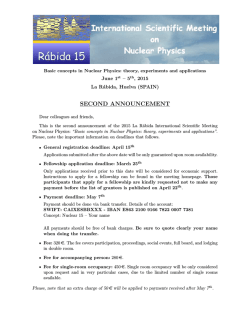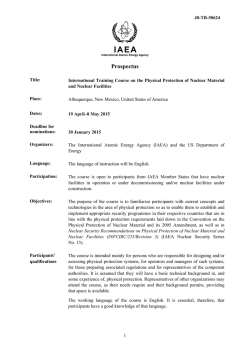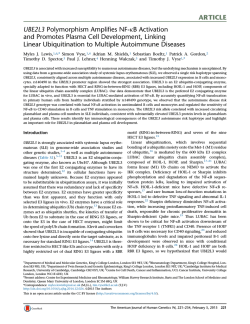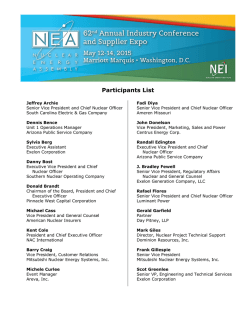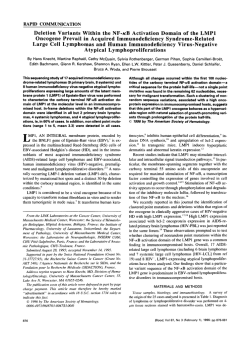
Cytoskeletal Control of Gene Expression: Depolymerization of
Published March 15, 1995
Cytoskeletal Control of Gene Expression: Depolymerization of
Microtubules Activates NF-xB
C a r i d a d Rosette a n d Michael K a r i n
Department of Pharmacology, School of Medicine, University of California at San Diego, La Jolla, California 92093-0636
Abstract. Cell shape changes exert specific effects on
majority of NF-xB resides in the cytosplasm as a
complex with its inhibitor IxB. Upon cell stimulation,
NF-KB translocates to the nucleus with concomitant
degradation of IKB. We show that cold-induced depolymerization of microtubules also leads to IKB degradation and activation of NF-~B. However, the activated factor remains in the cytoplasm and translocates
to the nucleus only upon warming to 37°C, thus revealing two distinct steps in NF-KB activation. These
findings establish a new role for NF-KB in sensing
changes in the state of the cytoskeleton and converting
them to changes in gene activity.
variety of observations suggest that changes in cell
shape or architecture can regulate gene expression
(6, 35). The shape of a cell is affected by interactions
with either the extracellular matrix or neighboring cells,
which lead to restructuring of the cytoplasmic cytoskeleton.
Altering cytoskeletal structure may in turn change the availability of regulatory or catalytic sites of key signal-transducing molecules. Some of the classical examples illustrating the effect of cell shape changes on nuclear gene
expression include a switch from type I to type II collagen
expression by condriocytes upon a shift from growth on
fibronectin to growth in suspension (7), as well as the repression of liver-specific gene expression in dispersed hepatocytes and its resumption upon cell aggregation (14). The exact mechanisms by which changes in cell shape are converted
to changes in the pattern of gene expression have not been
explained, but the cytoskeleton is a good candidate to have
a key role in this mysterious signal transduction process. It
has been suggested that the cytoskeleton may regulate gene
expression by interacting with the nuclear matrix (9), and
that this interaction may lead to physical expansion of nuclear pores and thereby increase the rate of nuclear transport
in spreading cells (35).
One of the major components of the cytoskeleton is the
microtubule network. Because of the dynamic instability of
tubulin dimers, this structure is subject to constant remodel-
ing. Massive microtubule reorganization occurs in the mitotic phase of the cell cycle (46), during cell differentiation
(36), upon specific binding of cytotoxic T lymphocytes to its
target cell (24), and during injury-induced migration of endothelial cells to wounded tissue (27). This massive microtubule reorganization correlates with changes in gene expression. Depolymerization of microtubules with drugs can
stimulate cell proliferation in the absence of other signals
(15), whereas stabilization of microtubules can inhibit the
action of certain mitogens (16). It was shown that transcription of several genes, including the ones that encode
urokinase type plasminogen activator (uPA)' (11, 38) and
interleukin IL-lfl (23, 44) is activated by microtubuledepolymerizing agents such as nocodazole and colchicine.
One plausible way by which the cytoplasmic cytoskeleton
can affect nuclear gene expression is by modulating the activity of transcription factors that reside in the cytoplasm of unstimulated cells in an inactive form and migrate to the nucleus in response to various stimuli (34). Such factors are
the NF-KBs, a collection of structurally and functionally
related dimeric complexes that activate transcription of immunoregulatory genes that encode cell surface receptors,
cytokines, acute phase reactants, and cell adhesion molecules (reviewed in reference 28). NF-rB was originally
characterized as a heterodimer of two subunits, p50 and p65,
each of which is also capable of homodimerizing and binding
Address correspondence to Michael Karin, Department of Pharmacology,
School of Medicine, University of California at San Diego, La Jolla, CA.
Tel.: (619) 534-1361. Fax: (619) 534-8158.
1. Abbreviations used in this paper: CAT, chloramphenicoI acetyl transferase; TPA, tetradecanoyl phorbol acetate; uPA, urokinase plasminogen activator.
© The Rockefeller University Press, 0021-9525/95/03/11 i 1/9 $2.00
The Journal of Cell Biology, Volume 128, Number 6, March 1995 1111-1119
1111
Downloaded from on October 2, 2016
gene expression. It has been speculated that the cytoskeleton is responsible for converting changes in the
cytoarchitecture to effects on gene transcription. However, the signal transduction pathways responsible for
cytoskeletal-nuclear communication remained unknown. We now provide evidence that a variety of
agents and conditions that depolymerize microtubules
activate the sequence-specific transcription factor
NF-xB and induce NFKB-dependent gene expression.
These effects are caused by depolymerization of microtubule because they are blocked by the microtubulestabilizing agent taxol. In nonstimulated cells, the
Published March 15, 1995
DNA on its own (25, 37, 50, 55, 56). The NF-KB family now
consists of multiple dimer-forming proteins with homology
to the tel oncogene (28). The cellular localization, DNA
binding, and transcriptional properties of the NF-KB proteins
are regulated by a second family of proteins, the IKBs, that
contain ankyrin-type repeats (10, 26, 41). The ankyrin-type
repeats of ankyrins are thought to form binding sites for integral membrane proteins and tubulin (17, 43). It was proposed
that IrB prevents NF-KB nuclear translocation by masking
the nuclear localization signal located in the Rel homology
domain common to these proteins (5, 62). This interaction
is mediated through the ankyrin-type repeats of IrB (31).
However, it is also possible that the ankyrin-type repeats of
IKB may make additional contribution to the cytoplasmic
retention of NF-rB through an interaction with cytoskeletal
components. This may allow the activity state of NF-rB to
be modulated by the cytoarchitecture and provide a mechanism for gene regulation in response to cytoskeletal changes.
In this paper, we demonstrate that microtuhule depolymerization can lead to activation of NF-KB- and NF-KB-dependent gene expression. These findings establish a signal transduction pathway that interprets changes in the state of the
cytoplasmic cytoskeleton and converts them to changes in
the activity of a sequence-specific transcription factor.
Reagents
TPA (stored at 100 ng/#l in ethanol), nocodazole (4 mg/ml in DMSO), colchicine (0.4 mg/ml in DMSO), vinblastine (10 mg/mi in ethanol), podophyllotoxin (50 #g/ml in PBS), taxol (10 mM in DMSO), ~-lumicolchicine (0.4
mg/ml in DMSO), cytochalasin D (1 mg/ml in DMSO), cyclobeximide (10
#tg in PBS), and monoclonal anti-{/-tubulin (mAb TUB2.1) were purchased
from Sigma Chemical Co. (St. Louis, MO). Rabbit anti-pS0 antibody was
generated against a synthetic NH2-terminal peptide (MAEDDPYLGRPEQK), rabbit anti-p65 antibody was generated against recombinant p65
(45), and rabbit anti-IKBc~was generated against recombinant IKBc~(21).
Cell Culture and Transfection
HeLa $3 cells were maintained in DME supplemented with 10% FBS, 2
mM glutamine, 100 U/ml penicillin and 100 #g/ml streptomycin. FOr induction experiments, cells were incubated with DME containing 0.5 % FBS
for 24 h and then treated with the different agents for the indicated time
periods. Human peripheral blood mononuclear cells prepared from whole
heparinized blood by density-gradient centrifugation on Ficoll-Paque (Pharmacia Fine Chemicals, Piscataway, NJ) were enriched in monocytes by adherence to plastic tissue culture plates for 4 h at 37°C in RPMI containing
3 % human serum. Nonadherent cells were removed by washing with media
and then treated with the different agents. FOr transfection experiments,
cells were fed with fresh medium containing 10% FBS 3 h before incubation
with calcium phosphate-DNA precipitate containing 2xKB-CAT (5 /~g).
2xn~B-CAT (5 #g), or -73 Col-CAT (2 pg). Each 100-ram culture dish was
transfected with a total DNA amount adjusted to I0 #g with pUC18.
Precipitates were left on cells for 4 h before shocking with 10% glycerol
for 3 min. Cells were washed twice with PBS and then refed with DME
containing 0.5 % FBS. Treatments with tetradecanoyl phorbol acetate (TPA)
(100 ng/ml) or nocodazole (0.4/~g/ml) were initiated 24 h later. The cells
were harvested after a 12-h induction period. Extracts were prepared by
sonicating, and chloramphenicol acetyl transferase (CAT) enzyme activity
was determined as described (2).
Preparation of CeUExtracts, Mobility Shift Assays,
and Immunoblotting
Cells were washed twice with PBS and then scraped off the plate with a rubber policeman. For preparation of whole cell extracts, cell pellets were
resuspended in high salt buffer C (20 mM Hepes, pH 7.9, 0.4 M NaCI,
The Journal of Cell Biology, Volume 128, 1995
PD
5'-TCGAGCGGCAGGGGAATTCCCCTCTCC3'
3' -CGCCGTCCCCTTAAGGGGAGAGGAGCT-
Col-TRE 5' -AGCTTAAAGCATGAGTCAGACACCT- 3'
3'
- ATTTCGTACTCAGTCTGTGGACTTAA-
Sp-1
5'
5'
5'-CGATCGGGGCGGGGCGCGATCGGGGCGGGGCG-3'
3'-GCTAGCCCCGCCCCGCGCTAGCCCCGCCCCGC-
5'
KB-ILI# 5" -AGCTTGAGACTCATGGGAAAATCCCACATTTGAT3'
3'CTCTGAGTACCCTTTTAGGGTGTAAACTATTCGA-
5'
To determine the binding specificity and nature of the complexes, cold
oligonucleotides or antibodies were preincubated with the extracts for 30
rain at 4°C before incubation with the reaction cocktail containing the
probe. Protein-DNA complexes were resolved on 5 % or 6% nondenaturing
polyacrylamide gels (acrylamide/bisacrylamide ratio -- 29:1) containing
0.25x TBE buffer at 200 V for 2 h at room temperature.
To detect IrBc~, 10-20 p.g cytoplasmic or whole-cell extracts were separated on 12 % SDS-polyacrylamide gel, transferred to a polyvinyldifluoride
membrane (Millipore Corp., Bedford, MA) for 3 h in buffer containing 25
mM Tris base, 200 mM glycine, and 15% methanol, then blocked in 5%
dry nonfat milk in PBS for 2-12 h, and then incubated in rabbit polycional
antibody to IKBc~,followed by anti-rabbit IgG coupled to horseradish peroxidase (Amersham Corp., Arlington Heights, IL). Immunoreactive bands
were detected with the ECL chemiluminescent kit (Amersham).
Preparation of dimeric and polymeric fractions of tubulin was described
as in (40). Briefly, dimeric fractions were collected using lysis buffer containing 80 mM Pipes-KOH, pH 6.8, 1 mM MgCIz, 2 mM EGTA, 0.5%
Triton X-100, and polymeric fractions were extracted from the remaining
Triton-insoluble material with 1% SDS in water. Extracts were analyzed by
immunoblotting with anti-/~-tubulin, and immunoreactive bands were detected as above. Chemiluminescence from each band was qnantitated after
pbosphorimaging in a molecular imaging system (GS-250; Bio Rad Laboratories, Hercules, CA).
Results
Activation of NF-r~Bby Nocodazole
To investigate whether disruption of the microtubule network affects NF-KB activity, we treated serum-starved HeLa
$3 cells with nocodazole, a reversible inhibitor of tubulin 13o.
lymerization (18). Nuclear extracts were examined for NFrB-binding activity by a mobility shift assay, using a palindromic NF-rB-binding site (60). As shown in Fig. 1 a,
nocodazole treatment resulted in rapid activation of NFKB-binding activity. The time course of NF-KB activation by
nocodazole lagged the time course of microtubule depolymerization by 15 min, determined either by staining with
anti-/~-tubulin antibody in indirect immunofluorescence of
intact cells (data not shown) or by immunoblot analysis of
dimeric and polymeric tubulin fractions (Fig. 1 b). Although
considerable depolymerization of microtubules was detected
1112
Downloaded from on October 2, 2016
Materials and Methods
1 ram EDTA, 1 mM DTT, 0.5 mM PMSE 2.5/~g/mi aprotinin, 2.5/~g/ml
leupeptin, 1/~g/ml bestatin, and 1/~g/nd pepstatin) containing 0.02 % NP-40
and rotated at 4°C for 30 rain. Particulate material was removed by centrifugation at 10,000 g for 5 rain. For preparation of cytoplasmic and nuclear
extracts, cell pellets were resnspended in bypotonic buffer A (10 mM Hepes,
pH 7.9, 10 mM KCI, 0.2 mM EDTA, 0.1 mM EGTA, 1 mM DTT, and protease inhibitors as indicated above), and they were allowed to swell on ice
for 15 rain. NP-40 was added to 0.02%, and the suspension was passed
six times through a 26.5-gauge needle. Nuclei were pelleted for 1 min at
10,000 g, and the supernatant was recovered as the cytoplasmic extract. The
nuclear pellet was resuspended in buffer C and rotated at 4°C for 30 rain.
Particulate material was pelleted, and the supernatant was recovered as described above. For the mobility shift assays, protein-DNA complexes were
formed at 4°C for 30 rain in 20 or 30 #1 of 12 mM Hepes, pH 7.9, 4 mM
Tris-HC1, pH 7.9, 60 mM KCI, 30 mM NaCI, 5 mM MgCI2, 5 mM DTT,
0.1 mM EDTA, 12.5% glycerol containing 5/~g poly(dI-dC), and 0.05 ng
of 32P-labeled DNA probe (,'~10,000 cpm). The oligonucleotide sequences
are as follows:
Published March 15, 1995
determined to correspond to the p50 homodimer-DNA
complex (Fig. 2). The total m o u n t of the p50 homodimerDNA complex was increased approximately threefold by the
nocodazole treatment. The anti-p50 antiserum had only a
small inhibitory effect on the activity of the major nocodazole-induced DNA-binding species, tentatively assigned as
the p50/p65 heterodimer. Treatment of the extracts with a
polyclonal antiserum raised against p65 (45) resulted in partial inhibition of NF-KB-binding activity without any noticeable effect on activity of the p50 homodimer. Although these
results do not distinguish whether the major (23-fold induction) nocodazole-induced binding species is p50/p65, Rel/
p65, or p65 homodimer, the electrophoretic mobility of the
nocodazole induced complex is identical to that of a phorbol
ester-(TPA) induced NF-rB complex (Fig. 3). Previous
analysis indicates that the major TPA-inducible binding activity in HeLa cells, to the immunoglobulin kappa enhancer,
is a p50/p65 heterodimer (21, 29). In addition, p65 homodimers bind rather inefficiently to the palindromic NF-KB
probe (60). Therefore, the nocodazole-induced binding activity is most likely the p50/IRi5 heterodimer. Oligonucleotide competition experiments confirm that this activity is
sequence specific (Fig. 2). Oligonucleotides containing irrelevant binding sites or mutated NF-rB-binding sites did
not compete (data not shown). The experiment shown in Fig.
Downloaded from on October 2, 2016
Figure 1. Induction of NF-KB-bindingactivity by nocodazole. After
serum starvation for 24 h, HeLa $3 cells were treated with 0.4
/~g/ml noeodazole for 15-120 rain before harvesting and preparation of whole-cell extracts or Triton-soluble and-insoluble fractions. (a) 5-/~g nuclear extracts were used in a mobility shift assay
with a palindromic NF-~B-binding site as probe. The migration positions of the NF-KBprotein-DNA complex (NF-rdt), a nonspecific
pmtein-DNA complex (NS), and the unbound probe (FREE) are
indicated. (b) Portions of the total Triton-soluble and -insoluble
fractions (5% of each) were immunoblotted with antibody to
fl-tubulin. Lanes 1, 3, 5, and 7were loaded with the Triton-soluble
fraction, which contains dimeric tubulin, and lanes 2, 4, 6, and 8
were loaded with the Triton-insoluble fraction, which contains
polymeric tubulin.
within 15 min of exposure to nocodazole, NF-xB-binding
activity is detectable after 15 min, but it is not maximum until 30-60 min. This lag in NF-KB activation suggests that
microtubule disruption does not directly induce nuclear NFrB-binding activity, but that an intermediate step is necessary for full activation.
In addition to the t)50/t)65 NF-KB heterodimer, the palindromic NF-KB binding site is recognized by the p50 homodimer and much less efficiently by p65 (60). To investigate
the nature of the nocodazole-induced NF-KB-binding activity, we used anti-p50 and anti-p65 antibodies. Incubation
with a polyclonal antiserum raised against an NH2-terminal
p50 peptide (45) resulted in complete supershift of a band
that previously (reference 52 and unpublished results) was
Figure 2. Characterization of the nocodazole-induced NF-~B-binding activity. Nuclear extracts from untreated (0) or nocodazole(0.4 ~g/ml; 60 rain; N) treated HeLa $3 cells (5-~g samples) were
used in mobility shift assays with the paiindromic NF-~B site as a
probe after preincubation with either 2 ~1 of rabbit polyclonal antisera raised against either an N-terminal p50 peptide (anti-pSO),
recombinant p65 (anti-p65), or an NH2-terminal c-jun peptide
(anti-dun), 2 ~1 of preimmune rabbit serum, or no additions (control). The uninduced and nocodazole-induced extracts were also
analyzed in the presence of 25-fold molar excess of unlabeled palindromic NF-KBsite (cold PD). The migration positions of the NF-~B
protein-DNA complex (NF-r.B), the p50 homodimer-DNA complex, nonspecific protein-DNA complexes (NS), and the unbound
probe (FREE) are indicated. The upper nonspecific complex (NS)
is generated by a component of rabbit serum. The supershifted
p50-DNA complex is indicated by the arrow.
Rosetteand Karin Activation of NF-rB by Microtubule Depolymerization
1113
Published March 15, 1995
Figure 3. NF-xB is specifically activated by nocodazole. Nuclear
Downloaded from on October 2, 2016
extracts (5 #g) from HeLa $3 cells that were either nontreated (0)
or treated with either noeodazole (0.4 #g/ml for 60 min; NOC) or
TPA (100 ng/ml for 60 min; TPA) were analyzed by mobility shift
assays with probes specific for either NF-xB, Spl, or AP-1. Only the
segments of each gel that contained the protein-DNA complexes
are shown in this figure. NS, nonspecific protein-DNA complex.
3 demonstrates that induction of NF-rB by nocodazole is almost as efficient as its induction by TPA, a well-characterized inducer of NF-rB activity (39). Induction by nocodazole
is specific to NF-xB since the binding activities of the constitutive transcription factor Spl and the TPA-inducible transcription factor AP-1 were not considerably affected by this
treatment.
A Variety ofMicrotubule DisruptingAgents
Activate NF-r~B
To determine whether the induction of NF-KB-binding activity by nocodazole is caused by its antimicrotubule activity,
we examined the effect of several microtubule-disrupting
agents that have different sites of action on the tubulin dimer
(42). As shown in Fig. 4 a, treatment with colchicine (CHC),
podophyllotoxin (PDP), and vinblastine (VSL) led to rapid
and efficient induction of nuclear NF-KB activity similar to
nocodazole, whereas the microtubule-stabilizing agent taxol
(20) or the inactive colchicine analog/3-1umicolchicine (22)
had no effect. An agent that causes depolymerization of actin
filaments, cytochalasin D (61), did not lead to induction of
nuclear NF-~B-binding activity. Further proof that the induction of NF-KB-binding activity is caused by depolymerization of microtubules is provided by the complete inhibition of NF-KB induction by microtubule-disrupting drugs by
pretreatment of the cells with taxol. As indicated by direct
#g/ml), colchicine (CHC; 40 #g/ml), podophyHotoxin (PDP; 50
ng/ml), vinblastine (FBL; 10 #g/ml), TPA (100 ng/ml), O-lumicolchicine (~CHC; 40 #g/rnl), cytochalasin D (CD; 2 #M), or with
no further additions (CON). 10 #g of nuclear extracts were used
Serum-starved HeLa $3 cells were preincubated in the absence ( - )
or in the presence (+) of taxol (5/~g/ml) for 30 rain, followed by
an additional 60-rain incubation with either nocodazole (blOC; 0.4
in a mobility shift assay with the palindromic NF-KBsite as a probe.
(b) lO-#g cytoplasmic extracts from the experiment described
above were immunoblotted with anti-IxB~ serum. The specific
IxB- band is indicated. (c) Human peripheral blood monocytes
were preincubated in the absence or presence of 5 #g/ml taxol
(TAX) for 30 rain, followed by an additional 60-rain incubation with
40 #g/ml colchicine (CHC), or with no further additions (0). 10-#g
whole-cell extracts were used in a mobility shift assay with the ILl/3 NF-xB site as probe.
The Journal of Cell Biology,Volume 128, 1995
1114
Figure 4. Micrombule depolymerization activates NF-KB. (a)
Published March 15, 1995
Figure 5. Effect of downregulation of protein kinase C and a protein
kinase inhibitor on activation of NF-~B by nocodazole. (a) Serumstarved HeLa $3 cells were treated with 100 ng/ml TPA for 24 h
and then washed twice with PBS to remove TPA. The cells were
then incubated for an additional 60 rain in fresh medium alone (O),
or in the presence of 0.4/zg/ml nocodazole (N), or 100 ng/ml TPA
(T). Nuclear extracts were prepared, and 5-/zg samples were used
in mobility shift assay with the palindromic NF-~B site as a probe.
(b) Serum-starved HeLa $3 were incubated for 60 rain in the presence or absence of the protein kinase inhibitor staurosporin (150
nM) without any further treatment or in the presence of either
noeodazole (NOC; 0.4 tJg/ml) or TPA (100 ng/ml). Nuclear extracts
were prepared, and 5-/zg samples were used in a mobility shift assay
with an NF-rB-specific probe.
Rosetteand KarinActivation of NF-rB by Microtubule Depolymerization
1115
Downloaded from on October 2, 2016
examination of mbulin polymerization, taxol pretreatment
also prevented microtubule depolymerization induced by
these drugs (data not shown). All NF-KB-inducing agents
analyzed thus far, cause the degradation of IKB (4, 12, 32,
53, 58). As shown in Fig. 4 b, induction of NF-rB-binding
activity correlates with the disappearance oflrBa. The level
of IKBo~quantitated by phosphorimage analysis of chemiluminescence from each band was reduced by six- and eightfold below the control value upon treatment with nocodazole and colchicine, respectively. Taxol, however, had
no effect on induction of NF-KB activity by TPA. NF-KB activation by microtubule disruption is not restricted to HeLa
cells since binding activity to an oligonucleotide corresponding to the NF-rB-binding site located in the IL-1/~ promoter
is induced in human peripheral blood monocytes treated
with colchicine, and this induction can be blocked with taxol
(Fig. 4 c).
Although taxol had no effect on induction of NF-rB activity by TPA, downregulation of protein kinase C by prolonged
incubation with TPA prevented the induction of NF-rB by a
second dose of TPA, but had no effect on the response to
nocodazole (Fig. 5 a). These results suggest that protein kinase C is not required for induction of NF-rB-binding activity by antimicrotubule drugs and that these agents induce
NF-rB by a different mechanism than TPA. However, a protein kinase is involved since the general protein kinase inhibitor, staurosporin, blocked nocodazole-induced NF-KB activity (Fig. 5 b). As expected, staurosporin also inhibited
most of the induction response to TPA.
The effect of nocodazole on microtubule is reversible
therefore removal of the drug allows microtubule repolymerization (19). Activation of NF-KB is reversed within 15 min
after removal of the drug unless the protein synthesis inhibitor cycloheximide was present during the recovery period
(Fig. 6 a, CHX). As indicated by immunoblot analysis of cytoplasmic extracts with anti-IrBa (Fig. 6 b), the return to
basal NF-KB-binding activity correlates with the reappearance of IrB~. The reappearance of IKB is most likely caused
by new synthesis since it is inhibited by cycloheximide.
These results suggest that inhibition of NF-rB activity after
repolymerization of microtubules is dependent on the continuing synthesis of IrBa. There is a lag in the induction of
NF-rB by microtubule disruption, but its inhibition is rapid
after repolymerization.
Published March 15, 1995
Microtubule Depolymerization Activates
NF-r,B-dependent Gene Expression
Figure 6. Microtubule repolymerization reverses NF-rB activation
by nocodazole. (a) Serum-starved HeLa $3 cells were incubated
for 30 min in the presence or absence of the protein synthesis inhibitor cycloheximide (CHX; 10 #M) without any further treatment
or in the presence of nocodazole (NOC;0.4 #g/ml) for 60 min. In
two samples, cells were washed extensively with PBS and then
replaced in medium containing or lacking cycloheximidefor 15 min
(NOC + 15'). Nuclear extracts were prepared, and 5-#g samples
were used in a mobility shift assay with an NF-xB-specific probe.
(b) 15-tLgcytoplasmic extracts derived from the same cells analyzed above were immunoblotted with a polyclonal antiserum to
IrBc~. The regions of the autoradiogram corresponding to the
specific IgBc~band is shown,
Exposure to Low Temperature Reveals Two Steps in
NF-r~BActivation
To examine whether the induction of NF-KB-DNA-binding
activity in vitro correlates with increased NF-KB-dependent
transcription in vivo, HeLa cells were transfected with a CAT
reporter gene controlled by a truncated c-fos promoter upstream to which two copies of the rB-binding site were inserted, 2xxB-CAT. As shown in Fig. 8, nocodazole treatment
stimulated CAT activity fourfold, while treatment with TPA
resulted in a 8.5-fold stimulation of CAT activity. Nocodazole or TPA treatment did not induce expression of a CAT
reporter containing two copies of a mutated version of the
xB site upstream of the c-fos promoter, 2xmrB-CAT. As was
shown in the mobility shift assays (see Fig. 3), nocodazole
had no effect on expression of an AP-l-dependent reporter,
-73Col-CAT (2), whereas TPA stimulated expression of this
reporter fivefold (Fig. 8). These results are consistent with
the notion that micrombule depolymerization results in
specific activation of NF-KB-dependent gene expression.
Discussion
To examine the effect of micrombule depolymerization on
NF-KB activity without using pharmacological agents, we incubated HeLa cells at 4°C for different time periods, and we
examined the distribution of NF-rB-binding activity between the cytosolic and nuclear fractions. Exposure to low
temperature is known to cause depolymerization of microtubules (51). As shown in Fig. 7 a, incubation of HeLa cells
at 40C for >~1 h elevated NF-KB-binding activity in the cytoplasmic fraction but not in the nuclear fraction. Upon warming to 37°C, NF-rB-binding activity appeared in the nuclear
fraction within 30 min. By contrast, nocodazole treatment
Over the years, many examples have been found that demonstrate a link between cell shape changes, the cytoskeleton,
and alterations in the program of gene expression (6). However, the signal transduction pathways by which the cytoskeleton can influence gene expression have remained a
mystery. The series of experiments described above demonstrate a pathway by which a major component of the cytoskeleton, the microtubule network, can affect the nuclear
transcriptional machinery by modulating the activity of a
specific transcription factor. We show that a variety of agents
and treatments that depolymerize microtubules cause rapid
and efficient activation of the transcription factor NK-KB and
The Journalof Cell Biology,Volume 128, 1995
1116
Downloaded from on October 2, 2016
led to rapid nuclear translocation of activated NF-KB, even
though a significant portion of activated NF-KB remained in
the cytoplasmic fraction. The cytoplasmic form of NF-KB is
unlikely to be derived from leakage from the nucleus during
cell fractionation since the p50 homodimer was exclusively
nuclear under all conditions. Nocodazole illicited a stronger
activation of NF-rB than cold depolymerization, and this
difference is reflected in the extent of IrBot degradation (Fig.
7 b; quantitation by phosphorimage analysis indicated a
12-fold decrease in NOC-treated cells compared to fourfold
decrease in cold treated cells after 60 rain of treatment). As
expected, the effect of low temperature exposure on NF-rB
activity correlates with its effect on microtubule integrity.
Immunoblotting of Triton-soluble and -insoluble fractions
using anti-~-tubulin antibody revealed considerable depolymerization of microtubules within 30 rain of incubation at
4°C and rapid recovery upon temperature upshift (data not
shown). These results suggest that NF-~B activation in response to microtubule depoloymerization occurs in at least
two steps. During the first step, NF-KB activation occurs in
the cytoplasm, and during the second step, it is translocated
to the nucleus. Since low temperature is likely to inhibit nuclear transport, an energy- and temperature-dependent process (49, 54), it causes the accumulation of free NF-KB in
the cytoplasm. Activation in the cytoplasm is consistent with
our previous results, where irradiation with ultraviolet C was
used to activate NF-~B in enucleated cells (21).
Published March 15, 1995
Figure 7. Activation of NF-xB by cold shock. HeLa $3 cells were incubated in control medium at either 37°C (CON, 0 time point) or
4°C, or in the presence of 0.4/zg/ml nocodazole (NOC) at 37°C for the indicated time periods (in minutes). An additional plate of cells
was incubated at 4°C for 120 min and then shifted to 37°C for 30 min (4-37°C). Ceils were harvested, and cytoplasmic and nuclear extracts
were prepared. (a) The level of NF-rB-binding activity was determined by mobility shift assays using nuclear extracts (5 #g) and cytoplasmic extracts (derived from the same number of cell equivalents as 5 ttg of nuclear extract) and a radiolabeled palindromic NF-rB probe.
The migration positions of the protein-DNA complexes formed by NF-rB, the p50 homodimer, and the nonspecific DNA binding protein
(NS) are indicated. (b) The level of IrBc~protein in the cytoplasmic extracts (15/~g/lane) was determined by immunoblot with an antiserum
to IrBct. Only the portion of the autoradiogram corresponding to the IrBc~ band is shown.
Figure 8. Nocodazole induces expression of an NF-rB--dependent
reporter gene. HeLa $3 cells were transfected with the indicated
reporter constructs, as described in Materials and Methods. The
fold induction was calculated relative to the level of expression of
each reporter in untreated cells. The nocodazole (NOC; 0.4 #g/ml)
and TPA (100 ng/ml) treatments were for 12 h, and they were initiated 24 h after transfection. The results shown represent the averages of four separate experiments for the 2xrB-CAT reporter and
three experiments for the 2xmrB-CAT and -73 Col-CAT reporters
that were used as controls.
Microtubule-depolymerizing agents were previously
shown to induce the expression of at least two genes, coding
for uPA (11, 38) and IL-I/3 (23, 44), both of which are also
inducible by phorbol esters and inflammatory mediators,
and are known to be regulated by NF-rB (29, 33). The mechanism of uPA transcription of colchicine was shown to involve AP-1 (13), while its activation by phorbol ester involves
NF-rB (29). We were not able to detect a considerable increase in AP-l-binding activity after microtubule depolymerization (Fig. 3), but binding activity to an oligonucleotide corresponding to the NF-rB-binding site in the uPA
promoter (29) is induced to the same extent as the palindromic NF-rB-binding activity after nocodazole treatment
(Rosette, C., unpublished result). The mechanism of IL-1/3
induction by microtubule depolymerization is unknown, although NF-kB may certainly be involved. It was shown that
colchicine induces the expression of IL-1/3 mRNA and protein in human monocytes (23, 44), and we found that NFrB-binding activity to an oligonucleotide corresponding to
the NF-rB-binding site located in the IL-1/3 promoter (33)
is induced in monocytes treated with colchicine (Fig. 4 c).
Interestingly, IrBt~ was cloned as a rapidly induced transcript in human monocytes after adherence (30), a cellular
state that is accompanied by changes in the organization of
the cytoskeletal network (8).
In addition to phorbol esters, NF-xB activity is induced by
TNF-ct, IL-1, bacterial lipopolysaccharide, and in a few
cases, by serum growth factors (reviewed in references 3, 28,
39). It is of interest that all of these agents are known to induce reorganization of the cytoskeleton (1, 47). Thus, it is
possible that partial or selective depolymerization of microtubules by any of these agents could be an intermediate
in the signaling pathway leading to activation of NF-KB, or
act in synergy with other more conventional pathways, such
as the activation of yet-to-be identified protein kinases,
thought to activate NF-xB through phosphorylation oflxB (3,
39). So far, however, we found that pretreatment with taxol
does not block the induction of NF-rB by either TPA (Fig.
4 a), TNF-c~, or serum (Rosette, C., unpublished results).
Therefore, none of these signals appear to rely on microtubule reorganization.
How does depolymerization of microtubules lead to acti-
Rosette and Karin Activation of NF-KB by Microtubule Depolymerization
1117
Downloaded from on October 2, 2016
thereby activate transcription of NF-rB-responsive genes.
Taxol, a microtubule-stabilizing agent, blocks the induction
of NF-rB by microtubule-disrupting agents and/3-1umicolchicine, an analogue of colchicine that does not disrupt microtubules, does not activate NF-rB. These results strongly
suggest that the observed induction is a direct and specific
response to microtubule depolymerization. Treatment of
cells with cytochalasin D, which causes depolymerization of
actin filaments, did not result in effective NF-xB activation.
Therefore, NF-rB activation is not caused by nonspecific and
general disruption of the cytoskeleton. In addition, the
DNA-binding activities of two other transcription factors,
Spl and AP-1, were not affected by the state of microtubule
polymerization.
Published March 15, 1995
We thank Joe DiDonato for helpful discussions and reagents and Ursula
Pirzer for the peripheral blood mononuclear cells.
This work was supported by grants from the National Institutes of Health
(NIH) (CA50528 and DIC38527). C. l~sette was supported by a minority
supplement to DIC38527 from the NIH.
Received for publication 30 June 1994 and in revised form 12 September
1994.
References
1. Allen, J. N., D. J. Herzyk, and M. D. Wewers. 1991. Colchicine has opposite effects on interleukin-1 beta and tumor necrosis factor-alpha production. Am. J. Physiol. 261:L315-321.
2. Angel, P., M. Imagawa, R. Chin, B. Stein, R. J. Imbra, H. J. Rahmsdorf,
C. Jonat, P. Herrlich, and M. Karin. 1987. Pborbol ester-inducible genes
contain a common cis element recognized by a TPA-modulated transacting factor. Cell. 49:729-739.
3. Bauerle, P. A. 1991. The inducible transcription activator NF-kappa B:
regulation by distinct protein subunits. Biochim. Biophys. Acta. 1072:
63-80.
4. Beg, A. A., T. S. Finco, P. V. Nantermet, and A. Baldwin, Jr. 1993. Tumor necrosis factor and interleuidn-1 lead to phospborylatin and loss of
I kappa B alpha: a mechanism for NF-kappa B activation. Mol. Cell, Biol.
13:3301-3310.
5. Beg, A. A., S. M. Ruben, R. I. Scheinman, S. Haskill, C. A. Rosen, and
A. Baldwin, Jr. 1992. I kappa B interacts with the nuclear localization
sequences of the subunits of NF-kappa B: a mechanism for cytoplasmic
retention. Genes & Dev. 6:1899-1913.
The Journal of Cell Biology, Volume 128, 1995
6. Ben-Ze'ev, A. 1991. Animal cell shape changes and gene expression. Bioessays. 13:207-212.
7. Benya, P. D., and J. D. Shaffer. 1982. Dedifferentiated chondrocytes reexpress the differentiated collagen phenotype when cultured in agarose gels.
Cell. 30:215-224.
8. Bershadsky, A. D., and Y. Vasiliev. 1989. Cytoskeleton. Plenum Press,
New York. 298 pp.
9. Bissell, M. J., H. G. Hall, and G. Parry. 1982. How does the extracellular
matrix direct gene expression? J. Theor. Biol. 99:31-68.
10. Blank, V., P. Kourilsky, and A. Israel. 1992. NF-kappa B and related proteins: Rel/dorsal homologies meet ankyrin-like repeats. Trends Biochem.
Sci. 17:135-140.
11. Botteri, F. M., K. Ballmer-Hofer, B. Rajput, and Y. Nagamine. 1990. Disruption of cytoskeletal structures results in the induction of the umkinasetype plasminogen activator gene expression. J. Biol. Chem. 265:1332713334.
12. Brown, K., S. Park, T. Kanno, G. Franzoso, and U. Siebenlist. 1993.
Mutual regulation of the transcriptional activator NF-kappa B and its inhibitor, I kappa B-alpha. Proc. Natl. Acad. Sci. USA. 90:2532-2536.
13. Carney, D. H., K. L. Crossin, R. Ball, G. M. Fuller, T. Albrecht, and
W. C. Thompson. 1986. Changes in the extent of microtubule assembly
can regulate initiation of DNA synthesis. Ann. NYAcad. Sci. 466:919932.
14. Clayton, D. F., A. L. Harrelson, and J. Darnell, Jr. 1985. Dependence of
liver-specific transcription on tissue organization. Mol. Cell. Biol. 5:
2623-2632.
15. Crossin, K. L., and D. H. Carney. 1981. Evidence that microtubule depolymerization early in the cell cycle is sufficient to initiate DNA synthesis.
Cell. 23:61-71.
16. Crossin, K. L., and D. H. Carney. 1981. Microtubule stabilization by taxol
inhibits initiation of DNA synthesisby thrombin and by epidermal growth
factor. Cell. 27:341-350.
17. Davis, J. Q., and V. Bennett. 1984. Brain ankyrin. A membrane-associated
protein with binding sites for spectrin, tubulin, and the cytoplasmic domain of the erythrocyte anion channel. J. Biol. Chem. 259: ! 3550-13559.
18. De Brabander, M. J., R. M. Van de Veire, F. E. Aerts, M. Borgers, and
P. A. Janssen. 1976. The effects of methyl (5-(2- thienylcarbonyl)-lHbenzimidazol-2-yl) carbamate, (R 17934; NSC 238159), a new synthetic
antitumoral drug interfering with microtubules, on mammalian cells cultured in vitro. Cancer Res. 36:905-916.
19. De Brahander, M., G. Geuens, R. Nuydens, R. Willebrords, and J. De
Mey. 1981. Microtubule assembly in living cells after release from
nocodazole block: the effects of metabolic inhitibors, taxol and pH. Cell.
Biol. Int. Rep. 5:913-920.
20. De Brabander, M., G. Geuens, R. Nuydens, R. Willebrords, and J. De
Mey. 1981. Taxol induces the assembly of free microtubules in living
cells and blocks the organizing capacity of the centrosomes and
kinetochores. Proc. Natl. Acad. Sci. USA. 78:5608-5612.
21. Devary, Y., C. Rosette, J. A. DiDenato, and M. Karin. 1993. NF-kappa
B activation by ultraviolet light not dependent on a nuclear signal. Science
(Wash. DC). 261:1442-1445.
22. Dustin, P. 1984. Microtubules. Springer-Verlag, Berlin. 482 pp.
23. Ferrna, B., S. Manic, A. Doglio, A. Shaw, S. Sonthonnax, M. Limouse,
and L. Schaffar. 1990. Stimulation of human interleukin 1 production and
specific mRNA expression by microtubule- disrupting drugs. Cell. lmmunol. 131:391-397.
24. Geiger, B., D. Rosen, and G. Berke. 1982. Spatial relationships of microtubule-organizing centers and the contact area of cytotoxic T lymphocytes
and target cells. J. Cell Biol. 95:137-143.
25. Ghosh, S., A. M. Gifford, L. R. Riviere, P. Tempst, G. P. Nolan, and D.
Baltimore. 1990. Cloning of the pS0 DNA binding subunit of NF-kappa
B: homology of rel and dorsal. Cell. 62:i019-1029.
26. Gilmore, T. D., and P. J. Morin. 1993. The I kappa B proteins: members
of a multifunctional family. Trends Genet. 9:427-433.
27. Gordon, S. R., and C. A. Staley. 1990. Role of the cytoskeleton during
injury-induced cell migration in corneal endothelium. Cell Motil.
Cytoskeleton. 16:47-57.
28. Grilli, M., J. J. Chiu, and M. J. Lenardo. 1993. NF-kappa B and Rel: participants in a multiform transcriptional regulatory system. Int. Rev. Cytol.
143:1-62.
29. Hansen, S. K., C. Nerlov, U. Zabel, P. Verde, M. Johnsen, P. A.
Beeuerle, and F. Blasi. 1992. A novel complex between the p65 subunit
of NF-kappa B and c-Rel binds to a DNA element involved in the phorbol
ester induction of the human urokinase gene. EMBO (Eur. Mol. Biol. Organ.) J. 11:205-213.
30. Haskili, S., A. A. Beg, S. M. Tompkins, J. S. Morris, A. D. Yurochko,
A. Sampson-Johannes, K. Mondal, P. Ralph, and A. Baldwin, Jr. 1991.
Characterization of an immediate-early gene induced in adherent monocytes that encodes I kappa B-like activity. Cell. 65:1281-1289.
31. Hatada, E. N., M. Naumann, andC. ScheidereR. 1993. Common structural
constituents confer I kappa B activity to NK-kappa B p105 and I kappa
B/MAD-3. EMBO (Fur. Mol. Biol. Organ.) J. 12:2781-2788.
32. Henkel, T., T. Machleidt, I. Alkalay, M. Krnnke, Y. Ben-Neriah, and
P. A. Baeuerle. 1993. Rapid proteolysis of I kappa B-alpha is necessary
for activation of transcription factor NF-kappa B. Nature (Lond.). 365:
1118
Downloaded from on October 2, 2016
vation of NF-~B? As with other inducers of NF-xB such as
TPA and TNF-ol (4, 12, 32, 58), microtubule disruption by
drugs and by cold treatment lead to IKB degradation (Figs.
4 b and 7 b). The critical step leading to I~B degradation may
be its phosphorylation (Karin, M., and T. Hunter, manuscript submitted for publication). Two protein kinases, MAP
kinase (57) and protein kinase A (44) were shown to be activated by colchicine. The kinase that phosphorylates IxB in
vivo has not been identified. Nevertheless, we find that incubation with the general protein kinase inhibitor, staurosporin, prevents the activation of NF-KB by nocodazole. Hence,
a protein kinase may be involved in this signaling event as
well. Alternatively, degradation of I~B may be triggered by
other mechanisms, such as ubiquitination. Interestingly,
ubiquitin and ubiquitin activating enzyme are localized to
microtubules (48, 59). Whatever the mechanism of IKB
degradation, our observations that the level of NF-KB-bindins activity induced by microtubule-disrupting drugs and by
cold treatment correlates well with the degree of IKBo~disappearance and that resuppression of NF-KB-binding activity
upon microtubule repolymerization is dependent on new
protein synthesis, suggest it is likely regulated by changes in
IKB level.
Although the exact biochemical process by which depolymerization of microtubules leads to activation of NF-KB remains to be elucidated, the present findings establish a role
for NK-~B in sensing changes in the state of the cytoskeleton
and converting them to changes in gene activity. While the
present work has relied on agents and treatments that cause
general depolymerization of microtubules, it is likely that
NF-~B and related transcription factors may actually become
activated in response to depolymerization of a small and
specific subset of the entire microtubule network. Since such
cytoskeletal changes are likely to be induced by cell-substrate and cell-cell interactions, this process would provide
a signal transduction pathway by which these physical interactions can modulate gene expression and thereby affect the
differentiated phenotype.
Published March 15, 1995
Rosette and Karin Activation of NF-rd~ by Microtubule Depolymerization
48, Mufti, K. G., H. T. Smith, and V. A. Fried. 1988. Ubiquitin is a component of the microtubule network. Proc. Natl. Acad. Sci. USA. 85:30193023.
49. Newmeyar, D. D., and D. J. Forbes. 1988. Nuclear import can be separated into distinct steps in vitro: nuclear pore binding and translocation.
Cell. 52:641-653.
50. Nolan, G. P., S. Ghosh, H. C. Liou, P. Tempst, and D. Baltimore. 1991.
DNA binding and I kappa B inhibition of the cloned 1065 subunit of NFkappa B, a tel-related polypeptide. Cell. 64:961-969.
51. Osdund, R., Jr., J. T. Leung, and S. V. Hajek. 1980. Regulation of
rnicrotubule assembly in cultured fibroblasts. J. Cell Biol. 85:386-391.
52. Radler-Pohl, A., I. Pfeaffer, M. Karin, and E. Setting. 1990. A novel
T-cell trans-activator that recognizes a phorbol ester-inducible element of
the interleakin-2 promoter. New Biol. 2:566-573.
53. Rice N. R., and M. K. Ernst. 1993. In vivo control of NF- kappa B activation by I kappa B alpha. EMBO (Eur. Mol. Biol. Organ.) J. 12:46854695.
54. Richardson, W. D., A. D. Mills, S. M. Dilworth, R. A. Laskey, and C.
Dingwall. 1988. Nuclear protein migration involves two steps: rapid
binding at the nuclear envelope followed by slower translocation through
nuclear pores. Cell. 52:655-664.
55. Ruben, S. M., P. J. Dillon, R. Schteck, T. Henkel, C. H. Chen, M. Maher,
P. A. Beeuerle, and C. A. Rosen. 1991. Isolation o f t rel-related human
cDNA that potentially encodes the 65-kD subunit of NF-kappa B. Science
(Wash. DC). 251:1490-1493.
56. Schmid, R. M., N. D. Perkins, C. S. Duckett, P. C. Andrews, and G. J.
Nabel. 1991, Cloning of an NF-kappa B subunit which stimulates HIV
transcription in synergy with p65. Nature (Lond.). 352:733-736.
57. Shinohara-Gotoh, Y., E. Nishida, M. Hoshi, and H. Sakai. 1991. Activation of microtubule-assoeiated protein kinase by microtubule disruption
in quiescent rat 3Y1 cells. F~p. Cell. Res. 193:161-166.
58. Sun, S. C., P. A. Ganehi, D. W. Ballard, and W. C. Greene. 1993. NFkappa B controls expression of inhibitor I kappa B alpha: evidence for
an inducible autoregulatory pathway. Science (Wash. DC). 259:19121915.
59. Transch, J. S., S. J. Grenfell, P. M. Handley-Gearhart, A. Ciechanover,
and A. L. Schwartz. 1993. Immunofluorescent localization of the
ubiquitin-activating enzyme, El, to the nucleus and cytoskeleton. Am. J.
Physiol. 264:C93-C 102.
60. Urban, M. B., R. Schreck, and P. A. Baeuerle. 1991. NF-kappa B contacts
DNA by a heterodimer of the p50 and p65 subunit. EMBO (Fur. MoL
Biol. Organ.) J. 10:1817-1825.
61. Yahara, I., F. Harada, S. Sekita, K. Yoshihira, and S. Natori. 1982. Correlation between effects of 24 different eytochalasins on cellular structures
and cellular events and those on actin in vitro. Z Cell Biol. 92:69-78.
62. Zabel, U., T. Henlde, M. S. Silva, andP. A. Baeuerle. 1993. Nuclear uptake control of NF-kappa B by MAD-3, an I kappa B protein present in
the nucleus. EMBO (Eur. Mol. Biol. Organ.) 3'. 12:201-211.
1119
Downloaded from on October 2, 2016
182-185.
33. Hiscott, J., J. Marois, J. Oaroufalis, M. D'Addario, A. Roulston, I. Kwan,
N. Pepin, J. Lacoste, H. Nguyen, G. Bensi, et al. 1993. Characterization
of a functional NF-kappa B site in the human interleukin I beta promoter:
evidence for a positive autoregulatory loop. MoL Cell. Biol. 13:62316240.
34. Hunter, T., and M. Karin. 1992. The regulation of transcription by phosphorylation. Cell. 70:375-387.
35. Ingber, D. E. 1993. The riddle of morphoganesis: a question of solution
chemistry or molecular cell engineering? Cell. 75:1249-1252.
36. Katagiri, K., T. Katagiri, K. Kajiyama, T. Yamamoto, and T. Yoshida.
1993. Tyrosine-pbosphorylation of tubulin during monocytic differentiation of HL-60 cells. J. lmmunol. 150:585-593.
37. Kieran, M., V. Blank, F. Logeat, J. Vandekerckhove, F. Lottspeich, O.
Le Bail, M. B. Urban, P. Kourilsky, P. A, Baeuerle, and A. Israel. 1990.
The DNA binding subunit of NF-kappa B is identical to factor KBFI and
homologous to the rel oncogene product. Cell. 62:1007-1018.
38. Lee, J. S., D. yon der Ahe, B. Kiefer, and Y. Nagamine. 1993. Cytoskeletal reorganization and TPA differendy modify AP-I to induce the
urokinase-type plasminogen activator gene in LLC-PKI cells. Nucleic
Acids Res. 21:3365-3372.
39. Lenardo, M. J., and D. Baltimore. 1989. NF-kappa B: a pleiotropic mediator of inducible and tissue-specific gene control, Cell. 58:227-229.
40. Lieuvin, A., J. C. Labbe, M. Doree, and D. Job. 1994. Intrinsic microtubule stability in interphase cells. J. Cell Biol. 124:985-996.
41. Liou, H. C., and D. Baltimore. 1993. Regulation of the NF-kappa B/rel
transcription factor and I kappa B inhibitor system. Curr. Opin. CellBiol.
5:477-487.
42. Luduena, R. F., and M. C. Roach. 1991. Tubulin sulfiaydryl groups as
probes and targets for antimitotic and antimicrotubule agents. Pharmacol
Ther. 49:133-152.
43. Lux, S. E., K. M. John, and V. Bennett. 1990. Analysis ofcDNA for human erythrocyte ankyrin indicates a repeated structure with homology to
tissue-differentiation and cell-cycle control proteins. Nature (Lond.).
344:36-42.
44. Manic, S., A. Schmid-Alliana, J. Kubar, B. Ferrua, and B. Rossi. 1993.
Disruption of microtubule network in human monocytes induces expression of interleukin-I but not that of interleukin-6 nor tumor necrosis
factor-alpha. Involvement of protein kinase A stimulation. J. Biol. Chem.
268:13675-13681.
45. Mercurio, F., J. A. DiDonato, C. Rosette, and M. Karin. 1993, p105 and
1098precursor proteins play an active role in NF-kappa B-mediated signal
transduction. Genes & Dev. 7:705-718.
46. Mitchison, T. J. 1989. Mitosis: basic concepts. Curr. Opin. Cell Biol.
1:67-74.
47. Molony, L., and L. Armstrong. 1991. Cytoskeletal reorganizations in human umbilical vein endothelial cells as a result of cytokine exposure. Exp.
Cell Res. 196:40-48.
© Copyright 2025
